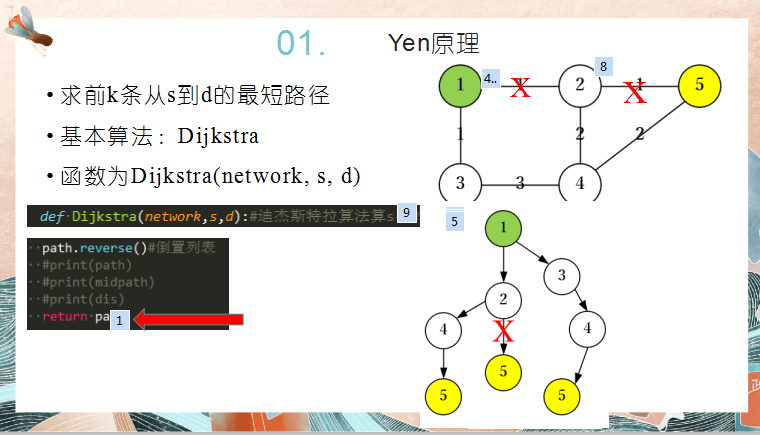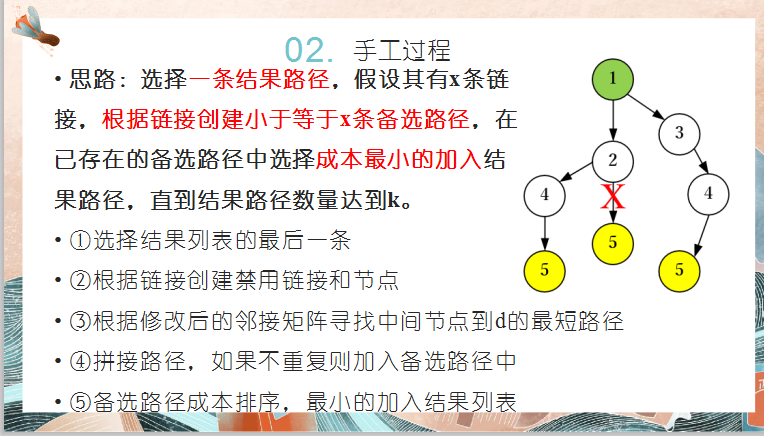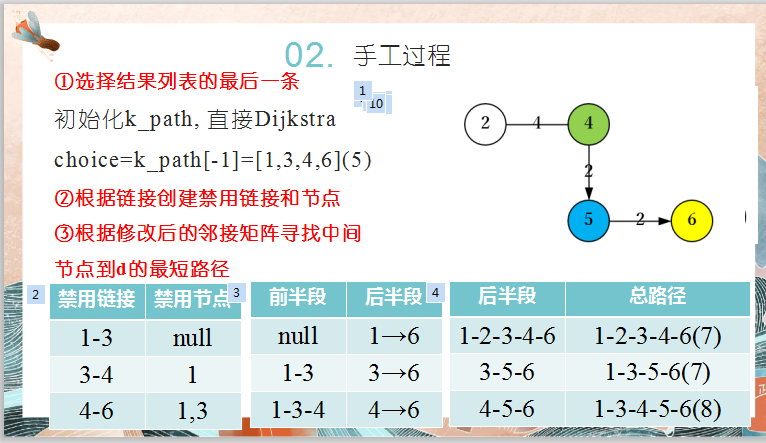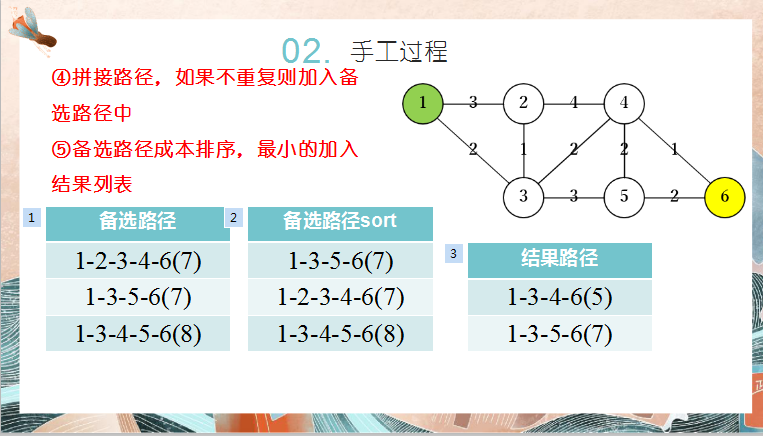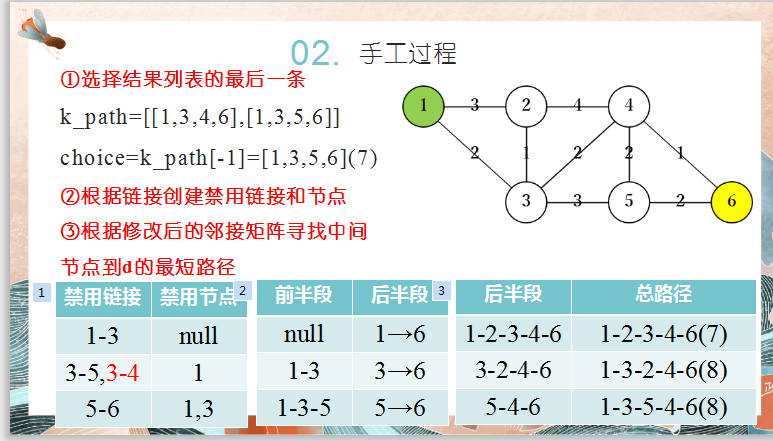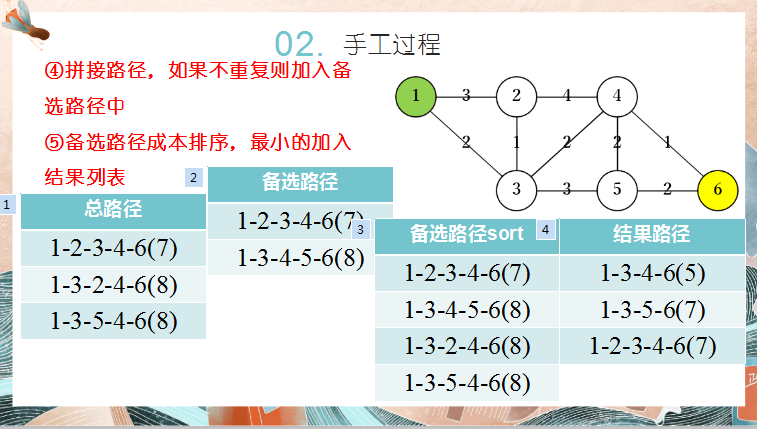老规矩,先上代码
#date:2021-5-17 #author:Linuas #b站:会武术的白猫 import copy def Dijkstra(network,s,d):#迪杰斯特拉算法算s-d的最短路径,并返回该路径和代价 #print("Start Dijstra Path……") path=[]#s-d的最短路径 n=len(network)#邻接矩阵维度,即节点个数 fmax=9999999 w=[[0 for i in range(n)]for j in range(n)]#邻接矩阵转化成维度矩阵,即0→max book=[0 for i in range(n)]#是否已经是最小的标记列表 dis=[fmax for i in range(n)]#s到其他节点的最小距离 book[s-1]=1#节点编号从1开始,列表序号从0开始 midpath=[-1 for i in range(n)]#上一跳列表 u=s-1 for i in range(n): for j in range(n): if network[i][j]!=0: w[i][j]=network[i][j]#0→max else: w[i][j]=fmax if i==s-1 and network[i][j]!=0:#直连的节点最小距离就是network[i][j] dis[j]=network[i][j] for i in range(n-1):#n-1次遍历,除了s节点 min=fmax for j in range(n): if book[j]==0 and dis[j]<min:#如果未遍历且距离最小 min=dis[j] u=j book[u]=1 for v in range(n):#u直连的节点遍历一遍 if dis[v]>dis[u]+w[u][v]: dis[v]=dis[u]+w[u][v] midpath[v]=u+1#上一跳更新 j=d-1#j是序号 path.append(d)#因为存储的是上一跳,所以先加入目的节点d,最后倒置 while(midpath[j]!=-1): path.append(midpath[j]) j=midpath[j]-1 path.append(s) path.reverse()#倒置列表 #print(path) #print(midpath) #print(dis) return path def return_path_sum(network,path): result=0 for i in range(len(path)-1): result+=network[path[i]-1][path[i+1]-1] return result def add_limit(path,s):#path=[[[1,3,4,6],5],[[1,3,5,6],7],[[1,2,4,6],8] result=[] for item in path: if s in item[0]: result.append([s,item[0][item[0].index(s)+1]]) result=[list(r) for r in list(set([tuple(t) for t in result]))]#去重 return result def return_shortest_path_with_limit(network,s,d,limit_segment,choice):#limit_segment=[[3,5],[3,4]] mid_net=copy.deepcopy(network) for item in limit_segment: mid_net[item[0]-1][item[1]-1]=mid_net[item[1]-1][item[0]-1]=0 s_index=choice.index(s) for point in choice[:s_index]:#s前面的点是禁用点 for i in range(len(mid_net)): mid_net[point-1][i]=mid_net[i][point-1]=0 mid_path=Dijkstra(mid_net,s,d) return mid_path def judge_path_legal(network,path): for i in range(len(path)-1): if network[path[i]-1][path[i+1]-1]==0: return False return True def k_shortest_path(network,s,d,k): k_path=[]#结果列表 alter_path=[]#备选列表 kk=Dijkstra(network,s,d) k_path.append([kk,return_path_sum(network,kk)]) while(True): if len(k_path)==k:break choice=k_path[-1][0] for i in range(len(choice)-1): limit_path=[[choice[i],choice[i+1]]]#限制选择的路径 if len(k_path)!=1: limit_path.extend(add_limit(k_path[:-1],choice[i])) mid_path=choice[:i] mid_res=return_shortest_path_with_limit(network,choice[i],d,limit_path,choice) if judge_path_legal(network,mid_res): mid_path.extend(mid_res) else: continue mid_item=[mid_path,return_path_sum(network,mid_path)] if mid_item not in k_path and mid_item not in alter_path: alter_path.append(mid_item) if len(alter_path)==0: print("总共只有{}条最短路径!".format(len(k_path))) return k_path alter_path.sort(key=lambda x:x[-1]) x=alter_path[0][-1] y=len(alter_path[0][0]) u=0 for i in range(len(alter_path)): if alter_path[i][-1]!=x: break if len(alter_path[i][0])<y: y=len(alter_path[i][0]) u=i k_path.append(alter_path[u]) alter_path.pop(u) for item in k_path: print(item) return k_path network=[[0,3,2,0,0,0], [3,0,1,4,0,0], [2,1,0,2,3,0], [0,4,2,0,2,1], [0,0,3,2,0,2], [0,0,0,1,2,0]] k_shortest_path(network,1,6,10)
运行结果
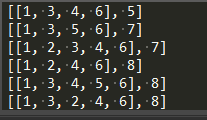
演示讲解


